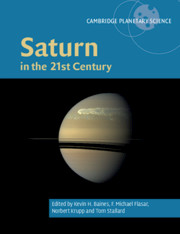Book contents
- Saturn in the 21st Century
- Cambridge Planetary Science
- Saturn in the 21st Century
- Copyright page
- Contents
- Contributors
- Reviewers
- 1 Introduction to Saturn in the 21st Century
- 2 The Origin and Evolution of Saturn, with Exoplanet Perspective
- 3 The Interior of Saturn
- 4 Saturn’s Magnetic Field and Dynamo
- 5 The Mysterious Periodicities of Saturn
- 6 Global Configuration and Seasonal Variations of Saturn’s Magnetosphere
- 7 Saturn’s Aurorae
- 8 Saturn’s Ionosphere
- 9 Saturn’s Variable Thermosphere
- 10 Saturn’s Seasonally Changing Atmosphere
- 11 The Global Atmospheric Circulation of Saturn
- 12 Saturn’s Polar Atmosphere
- 13 The Great Saturn Storm of 2010–2011
- 14 The Future Exploration of Saturn
- Index
- References
5 - The Mysterious Periodicities of Saturn
Clues to the Rotation Rate of the Planet
Published online by Cambridge University Press: 13 December 2018
- Saturn in the 21st Century
- Cambridge Planetary Science
- Saturn in the 21st Century
- Copyright page
- Contents
- Contributors
- Reviewers
- 1 Introduction to Saturn in the 21st Century
- 2 The Origin and Evolution of Saturn, with Exoplanet Perspective
- 3 The Interior of Saturn
- 4 Saturn’s Magnetic Field and Dynamo
- 5 The Mysterious Periodicities of Saturn
- 6 Global Configuration and Seasonal Variations of Saturn’s Magnetosphere
- 7 Saturn’s Aurorae
- 8 Saturn’s Ionosphere
- 9 Saturn’s Variable Thermosphere
- 10 Saturn’s Seasonally Changing Atmosphere
- 11 The Global Atmospheric Circulation of Saturn
- 12 Saturn’s Polar Atmosphere
- 13 The Great Saturn Storm of 2010–2011
- 14 The Future Exploration of Saturn
- Index
- References
Summary
The rotation rate of a planet is a fundamental parameter, no less than its mass or composition, and planetary investigators require this rate to assess various other phenomena such as planetary wind speeds, internal and atmospheric models, ring dynamics and so forth. Saturn presents a conundrum, however, because none of its various planetary periods indicates the “true” rotation of the planet. Thus, although the planet displays an abundance of periodicities near 10.7 hours, the exact rotation period of Saturn is unknown. In the magnetosphere, “planetary-period oscillations” (PPOs) appear in charged particles, magnetic fields, energetic neutral atoms, radio emissions and motions of the plasma sheet and magnetopause. In Saturn’s rings, the spoke phenomenon can exhibit periodicities near 10.7 hours, and ring phenomena themselves may be related to the interior rotation of the planet. In the high-latitude ionosphere, modulations near this period appear in auroral motions and intensities. In the upper atmosphere, some cloud features rotate near this period, although wind speeds are generally faster, and the well-known polar hexagon rotates with a period close to 10.7 hours. Some of the magnetospheric/ionospheric oscillations differ in the northern and southern hemispheres and their periods do not remain constant, sometimes varying on long time scales of a year or longer and sometimes on much shorter time scales. These variations in the period argue against a cause related to changes interior to Saturn, and because the magnetic and spin axes of Saturn are reported to be axisymmetric (unlike those of any other known planet), Saturn’s periodicities cannot be explained as “wobble” caused by a geometric tilt or by a nondipolar magnetic anomaly. Several models have been proposed to account for the observed periodicities, including rotating atmospheric vortices, periodic plasma releases and a flapping magnetodisk, but none can satisfactorily explain all of Saturn’s periodicities nor their common origin, and none can determine the exact rotation rate of the planet. This chapter reviews Saturn’s periodicities, theories thereof, and how they might be used to determine the elusive rotation rate of the planet.
- Type
- Chapter
- Information
- Saturn in the 21st Century , pp. 97 - 125Publisher: Cambridge University PressPrint publication year: 2018
References
- 3
- Cited by



